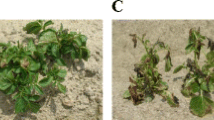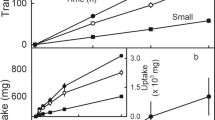Abstract
An understanding of wound healing in potato tubers is important for reducing shipping and storage losses. Because excised tissue cores are often used in studies of the wound responses of tubers, we compared the healing of cores to that of cuts and bruises on whole tubers. To do this, we measured water loss from cores by weighing and the vapor transfer from both cut areas and bruises on tubers using a commercial leaf porometer (stomatal meter).
Vapor loss from cut surfaces on whole tubers decreased more rapidly than that from cores of tissue. Variability of conductance measurements among individual tubers with cut surfaces was less than that among cores measured on a given day after excision. The rate at which either cores or the cuts on tubers healed did not change significantly as time in storage varied from 2 to 27 weeks before injury.
Bruises made on whole tubers usually healed more slowly than cut surfaces on tubers. Severity of the bruise made by a pendulum striker depended on the turgor pressure of the tuber tissue. Tubers cells had high turgor pressure (nearly 0.4 MPa) early in the storage season and the striker created shatter bruises. With a decline in turgor to < 0.2 MPa with storage time, little or no shatter bruising occurred.
Wound healing differed among tissue cores, cut surfaces on whole tubers and bruises on whole tubers, raising concern over the suitability of cores as a model for studying tuber response to injuries. The porometer was a reliable and relatively convenient method of assessing wound healing of both cuts and bruises on whole tubers.
Similar content being viewed by others
Literature Cited
Bland, W.L. and C.B. Tanner. 1986. Potato tuber water potential components during storage. Am Potato J 63:649–653.
Buelow, F.H., E.A. Maher and A. Kelman. 1985. Assessment of bacterial soft rot potential in potatoes. Am Soc Agric Engr Meetings Paper 84-4030, 23–26 June, Michigan State Univ., 12 p.
Dean, B.B. and G.S. Campbell. 1974. Prediction of potato storage losses, p. 75–78.In Proc 13th Ann Washington State Potato Conference.
Jarvis, M.C. and H.J. Duncan. 1979. Water loss from potato tuber discs: a method for assessing wound healing. Potato Res 22:69–73.
Kolattukudy, P.E. and B.B. Dean. 1974. Structure, gas chromatographic measurement, and function of suberin synthesized by potato tuber tissue slices. Plant Physiol 54:116–121.
Maher, E.A. and A. Kelman. 1984. Influence of wounding and time in storage on susceptibility of Russet Burbank potatoes toErwinia carotovora ( EC). Phytopathology 74:880 (Abstr. No. 724).
McGee, E., M.C. Jarvis and H.J. Duncan. 1985. Wound healing in potato tuber tissue. 1. Effects of maturity at harvest. Potato Res 28:91–99.
Nnodu, E.C., M.D. Harrison and M. Workman. 1982. The effect of storage environment on the infection of potato tubers byAlternaria solani. Am Potato J 59:313–325.
Parlange, J. and P.E. Waggoner. 1970. Stomatal dimensions and resistance to diffusion. Plant Physiol 46:337–342.
Perombelon, M.C.M. 1972. A quantitative method for assessing virulence ofErwinia carotovora var.carotovora andE. carotovora var.atroseptica and susceptibility of rotting of potato tuber tissue. pp 299–303.In: H.P. Maas Geesteranus (ed.), Proceedings of the Third International Conference on Plant Pathogenic Bacteria (Wageningen, The Netherlands). Center for Agricultural Publishing and Documentation, Wageningen, The Netherlands.
Smith, B.G. and P.H. Rubery. 1981. The effects of infection byPhytophthora infestans on the control of phenylpropanoid metabolism in wounded potato tissue. Planta 151:535–540.
Theologis, A. and G.G. Laties. 1981. Wound-induced membrane lipid breakdown in potato tuber. Plant Physiol 68:53–58.
Author information
Authors and Affiliations
Additional information
Research supported by the College of Agricultural and Life Sciences, University of Wisconsin-Madison and by USDA Hatch formula funds (Project 142-5140).
Rights and permissions
About this article
Cite this article
Bland, W.L., Tanner, C.B. & Maher, E.A. Vapor conductance of wounded potato tuber tissue. American Potato Journal 64, 197–204 (1987). https://doi.org/10.1007/BF02853464
Accepted:
Issue Date:
DOI: https://doi.org/10.1007/BF02853464




